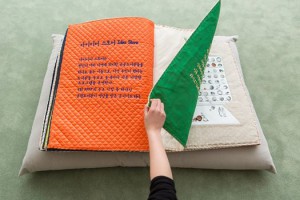4th Anyang Public Art Project
Public Story
March, 28 – June, 8, 2014
Artistic Director: Jee-sook Beck
The 4th APAP highlights the key episodes of the previous APAP editions in which Korean civil society and history, public art and contemporary art, or contemporary art and the public, intersected. We will weave a “fabric of stories” with these episodes from a variety of perspectives. The APAP Public Story proposes the following: for a knowledge commons, stories from each of you listening through the mind. It is a story about public stories; it reconsiders the capacity to tell stories, and it resonates with the re-storytelling that seeks to listen.
The distinctive feature of the APAP Public Story is that it takes place in space rather than in time. The space, in this case, is at once a concrete site, a cyberspace, and a u-topia. In fact, Public Story, which relies entirely on the relationship between the narrator and the listener, is a story that could be found anywhere. The backdrops of Public Story are the historical site of Anyang-sa, a Buddhist temple, where the city of Anyang is presumed to have originated, and Anyang Art Park, the site where APAP was launched. There, we find the Anyang Pavilion, the “brain” of APAP, and the Kim Chung Up Museum, Anyang’s “DNA.” On the one hand, it could be said that the three previous APAPs, or the history of Anyang, or the state of contemporary politics, ethics, or aesthetics is the backdrop of the 4th APAP. However, it is the fate of APAP to constantly evolve and to transform itself in that it is also the hearts and minds of the people living today that is its backdrop.
The 4th APAP takes the media for communicating Public Story as one of its themes. It began as a means to address the difficult problems of maintaining public installation works, but the issue demanded more attention as public media are not merely a technology or a material but an active relationship or activity that transforms media. Public media shares a common thread with modern media in that they overcome the social and physical limitations of identity and distance and mediate the event of the other and the action of the viewer.
Unless we are telepathic, the only way we can respond to and sympathize with the thoughts of the other is through media. Or these thoughts become amplified and transformed within ourselves and are extended into the world in the form of an action. Therefore, what is transmitted through public media is not the story itself but the body that changes in the process of telling the story or the experience thereof. Affect, or the ability to influence or be influenced, may be viewed as the final result of Public Story in that it creates a passage for a certain state of bodily experience to go toward yet another kind of experience. In that sense, affect is purely transitive; it is not commanding or vicarious. Moreover, it is implementational rather than merely communicational.* There lies the reason why Public Story continues to thrive.
About Artistic Director Jee-sook Beck
Artistic Director of Atelier Hermès since 2011, Beck Jee-sook was Director of the Arts Council Korea (ARKO) Art Center and Project Director of Insa Art Space from 2005 to 2008. She served as Curator of the Insa Art Space and Chief Curator of the Marronnier Art Center from 2000 to 2004.
Photo: A one of a kind fabric book explaining 20 keywords from the 4th APAP’s Public Art Glossary, with illustrations. Letters are written in large-type to meet the needs of the young and elderly. Courtesy APAP


